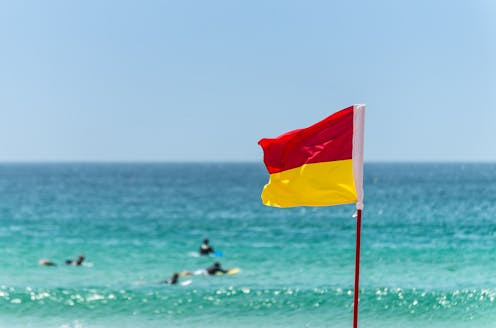Despite decades of beach safety ads, at least 55 people have drowned in Australia this summer. It’s time to change tack
- Written by Samuel Cornell, PhD Candidate, UNSW Beach Safety Research Group + School of Population Health, UNSW Sydney

Australia is considered a nation of beach lovers. But with all this water surrounding us, drownings remain tragically common. At least 55 people have drowned in waterways in Australia so far this summer, most of whom drowned at the beach. And the season’s not over.
Every drowning is a tragedy, and Australia is nowhere near the federal-government supported goal of zero drownings.
Public health agencies are concerned about the drowning numbers. So how do we fix it? An important factor to consider is how beach safety messages are communicated.
Another season, another campaign
The peak water safety bodies in Australia, Surf Life Saving Australia and Royal Life Saving Society – Australia, work to reduce drownings in all Australian aquatic locations, from swimming pools to rivers to beaches.
Their public safety campaigns aim to raise awareness of drowning and risks around the water. Australians are undoubtedly safer because of the work and advocacy of these organisations – but drowning numbers remain stubbornly high.
Surf Life Saving Australia is running a new campaign this summer – Stop, Look, Stay Alive – featuring Australian-born actor and filmmaker Angus Sampson.
This campaign is one of many in recent years urging Australians to stay safe near the water. Others include:
But the tragic number of drownings, particularly during summer, suggests not everyone is heeding the message. In fact, Australian researchers in 2022 found no evidence to suggest beach drowning deaths in Australia have reduced over the long term. This, the researchers said:
rais[es] questions regarding the effectiveness of existing strategies designed to communicate messages and information about beach safety and hazards to the public.
Changing how we communicate
According to Surf Life Saving Australia the current Angus Sampson campaign aims to be:
appealing to more Aussies, in particular men who continue to swim at unpatrolled locations and take unnecessary risks.
As the organisation notes, 86% of all drowning deaths on Australia’s coast last year were men.
The campaign involves ads on television and online, as well as outdoor advertising. The decision to use a mix of platforms is wise.
But the use of a TV and movie celebrity may not be effective. A review looking at road safety campaigns, for example, found limited evidence of celebrity effectiveness in improving safety outcomes.
Could it be more effective to, for example, use a TikTok star who is hugely popular among young males?
Research suggests using the right platform and “voices that matter” offer benefits when delivering safety messages. This is in part due to the emotional connection people form with these social media stars, which can result in behaviour change.
When asked for evidence to show the current public messaging campaigns are working, Surf Life Saving Australia (SLSA) told The Conversation:
SLSA is committed to preventing drowning through holistic, evidence-based approaches, combining awareness programs like Stop Look Stay Alive with lifesaving services, in-person programs, and education. This summer alone, lifesavers have performed over 2,500 rescues and 700,000 preventative actions.
Despite population growth, coastal drowning has remained stable. This summer, 32 coastal drownings have been reported, fewer than the same period last year. SLSA focuses on behaviour change through initiatives like beachpassport.org.au (with 21,000+ “passports” issued already!), and on-beach programs that have provided active community learning opportunities.
It’s too early to comment on the broader effectiveness of Stop Look Stay Alive, however preliminary campaign results show positive impact and an evaluation will be conducted by UNSW Beach Safety Research Group later this year.
Rethinking ‘swim between the flags’
Many current beach messaging approaches, including “swim between the flags”, compel people to fit into what the system wants.
But many beaches don’t have flags. And not everyone stops or looks for flags, signs, or even the conditions before they go into the water.
And studies show while most domestic beachgoers know to swim between the flags, many choose not to because, for example, people are located closer to beaches without flags or lifeguard patrols.
What’s more, research suggests overseas visitors to Australia do not always understand what “swim between the flags” means or terms often used on common beach safety signage such as “shore dump” and “shore break”. One 2021 study found 21% of international students perceived “always swim between the flags” to mean that beachgoers who don’t or can’t swim need to stay outside the flags.
This shows that current strategies aren’t resonating with all beach users, and there’s a need to reassess beach safety messaging.
Changing tack
Other forms of public safety messaging should also be considered when trying to reduce drowning numbers in Australia.
For example, people who have been caught in rip might be encouraged to tell their stories publicly. Research into other areas of public health communication, such as vaccines, suggest this can form the basis of an effective campaign.
Research also suggests teaching beachgoers about coastal science can improve beach safety behaviour. For example, people can be taught about how rip currents work, using images of dye released into the water.
Crucially, consensus is needed on which key messages to prioritise. Too much differing messaging may lead to message fatigue or confusion about which message is most important to follow.
Messaging on beach safety to date has surely prevented drowning. But the stubborn drowning toll highlights the need to evaluate what is not working. Clear and consistent messaging, using modern platforms and engaging influencers may help us to get to zero drownings sooner.
Authors: Samuel Cornell, PhD Candidate, UNSW Beach Safety Research Group + School of Population Health, UNSW Sydney





